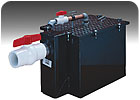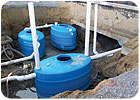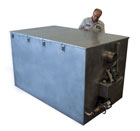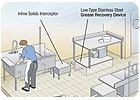
Kitchen grease, commonly referred to as FOG (fats, oils and grease), is an unavoidable by-product from food preparation and food serving areas. It also is a major problem in municipal/public sanitary systems.
The term “kitchen grease” is a generic term to cover any facility that is processing food, cooking food and/or serving food for the public. While there are other industrial sources of FOG-such as frozen food and other food processors-in most cities, the FOG problem stems from the small but daily incremental grease discharged by kitchens. This grease floats initially on the surface of the water as it flows through the drainage system. Often, the grease enters the public sanitary system and clings to the pipes at the flowing water level. The grease then continues to accumulate until the flow in the drainage system is restricted enough to cause sewer back ups and overflows.

The
Model 8000GT from Jay R. Smith Mfg. Co. is an example of a grease interceptor
with semi-automatic draw off.
Sanitary Sewer Overflows & Backups
It has been acknowledged by several sources that the majority of Sanitary Sewer Overflows (SSOs) are related to the buildup and blockages associated from FOG. These overflows often discharge directly into wetlands, lakes, rivers, streams or the ocean, or indirectly to them through storm drains. The resulting SSOs are a violation of the Federal Clean Water Act, illegal and costly to clean up. They have resulted in millions of dollars in fines by the EPA against cities, towns and sanitary sewer districts.For example, the Sanitation Districts of Los Angeles County has agreed to pay more than $2.5 million to settle a dispute over a large spill earlier this year where more than 800,000 gallons of sewage spilled into the Pacific Ocean and coastal groundwater supplies. After the incident, sanitation district officials vowed to make sure that other pumping stations didn’t have similar problems. As a part of the settlement, the Sanitation Districts would be released from liability for the 93 sewage spills in the last five years.
Although the large SSOs and associated EPA fines may be getting the most attention, FOG also causes the clogging in pipes that results in many sewer backups. These backups too often result in sewerage in someone’s basement or causing an overflowing toilet. Imagine the inconvenience and cost of just one sewer overflow in a restaurant. The best solution to preventing a sewer overflow is to capture FOG as close to the source as possible and as soon as possible. Remember, kitchen grease is food waste and should be disposed of first like all food waste-in the trash! This simple suggestion is just one way to capture kitchen grease before it reaches the drainage system.
Whether publicly or privately owned, the wastewater treatment facility should have a pretreatment coordinator. This is the person responsible to monitor what is discharged from a private source into the public sewer distribution. The pre-treatment coordinator must be sure that what he allows in the wastewater drainage system can be treated or removed at the treatment plant before the wastewater is returned into the environment. The EPA has jurisdiction and sets the limits on what can be discharged, and the treatment facility has the responsibility to comply. The EPA has encouraged local jurisdictions to adopt “FOG Ordinances” to regulate the wastewater discharge from restaurants and like facilities.

Outdoor
installation of gravity-type grease interceptors. These Procepter™ GMC units by
Green Turtle Americas Ltd. hold 200 gallons each.
Need For Grease Interceptors
Restaurants and similar establishments create two classes of FOG, yellow and brown. Yellow grease is the grease collected from fryers and similar equipment. Yellow grease can be recycled for uses such as cosmetics, glycerin products, bio-diesel and some animal feed supplements. The second grease, brown grease is any grease that has touched water. Brown grease is commonly from sources such as grease interceptors, water wash exhaust hoods, lift stations and wastewater treatment facilities. Brown grease cannot be recycled for any use involving contact with or consumption by animals or humans. Acceptable recycle uses of brown grease include paints, polymers, incinerator co-fuel and compost.FOG can be drastically reduced with simple, good grease-handling procedures. Once FOG goes down the drain, only a properly installed and maintained grease interceptor will prevent unwanted FOG from entering the public sewer system. Two types of grease interceptors are recognized by the plumbing codes and local pretreatment wastewater programs: hydro mechanical and gravity.
Hydro mechanical grease interceptors (covered by the Plumbing and Drainage Institute Standard G101) are compact in size and generally installed inside a building. They separate grease quickly (about one minute) due to several simultaneous actions: hydraulic flow, air entrainment and the difference in specific gravity between water and FOG. Gravity grease interceptors must be large and are usually installed outside underground. They require an extended time for grease separation (30 minutes or more), simply due to the specific gravity difference between FOG and water.
Standard G101 requires performance testing, which measures the actual grease removal efficiency for hydro mechanical grease interceptors. While there are standards for the gravity grease interceptors, these standards regulate leakage, labeling and construction requirements, not the grease removal efficiency.
There has been an ongoing debate on the effectiveness of the hydro mechanical grease interceptor vs. the gravity interceptor. A practical field study has been done by the Orange County (CA) Sanitation District, which referred to hydro mechanical grease interceptors as “Passive Traps” in their final report. The conclusion of the study states, “Passive grease traps are an important FOG control option and are utilized throughout the country.” The study also points out that monitoring and maintenance are necessary for the proper continued functioning of any grease interceptor.

A
large-capacity automatic grease removal device (GRD), the model GI2000A by
Josam Co.
When the automatic grease removal device is combined with a hydro mechanical grease interceptor, the combination is referred to as a grease removal device (GRD). The GRD first separates the grease from the wastewater and then automatically removes that grease from the interceptor to a container or barrel where it can be recycled or disposed of as food waste.
In conclusion, the best practices for capturing kitchen grease will always be a combination of good common-sense kitchen practices and properly sized, installed and maintained grease interceptors.

Commercial Kitchen Set-up
Sidebar: Separating the Myths From Facts About Grease Collection
Here are some myths about grease separation and collection that are worth clearing up.Myth:The larger the grease storage, the more efficient the interceptor.
Fact: Grease must be separated from the waste water before it can be stored. Storage capacity and grease removal efficiency are not related.
Myth: The grease must cool and harden to separate from the waste water.
Fact: Grease interceptors separate based on the difference in specific gravity of FOG and water. Liquified grease floats just as well as solidified grease. Grease is lighter than water.
Myth:Hot water will melt the grease and wash the grease through the interceptor.
Fact: All hydro mechanical grease interceptors are tested for grease removal efficiency with 150
Sidebar 2: A List of Best Management Practices
What goes down the drain from each plate or pan may seem minor and unimportant, but it isn’t! The facts are well substantiated; FOG all too often does not reach the treatment plant but accumulates in the municipal waste drainage system.The following are some simple overall guidelines for restaurants and food preparation businesses to achieve maximum success in capturing kitchen grease-and be an effective first line of defense against Sanitary Sewer Overflows:
*Train kitchen staff on grease handling practices.
*Hang posters explaining proper grease handling in the kitchen.
*Always dispose of food waste in the trash, never in the sanitary sewer system.
*Clearly identify grease-recycling containers.
*Provide ample paper towel dispensers for dry wiping grease from spills, pots, frying and grilling equipment.
*Contract with grease haulers/recyclers.
*Use strainer baskets in sinks to catch food waste.
*Direct all drains from grease producing sources to a properly sized grease interceptor.
*Avoid food grinders. If grinders are approved, discharge them to a solids interceptor prior to a grease interceptor.
*Schedule regular maintenance and cleaning of grease interceptors and keep a log of maintenance performed.
*Have a copy of the recommended grease interceptor cleaning procedures on site.